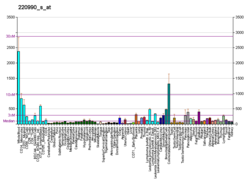| VMP1 |
|---|
|
| Identifiers |
|---|
| Aliases | VMP1, EPG3, TANGO5, TMEM49, vacuole membrane protein 1 |
|---|
| External IDs | OMIM: 611753; MGI: 1923159; HomoloGene: 23686; GeneCards: VMP1; OMA:VMP1 - orthologs |
|---|
| Gene location (Human) |
|---|
 | | Chr. | Chromosome 17 (human)[1] |
|---|
| | Band | 17q23.1 | Start | 59,707,192 bp[1] |
|---|
| End | 59,842,255 bp[1] |
|---|
|
| Gene location (Mouse) |
|---|
 | | Chr. | Chromosome 11 (mouse)[2] |
|---|
| | Band | 11|11 C | Start | 86,474,691 bp[2] |
|---|
| End | 86,574,662 bp[2] |
|---|
|
| RNA expression pattern |
|---|
| Bgee | | Human | Mouse (ortholog) |
|---|
| Top expressed in | - blood
- monocyte
- epithelium of colon
- gallbladder
- rectum
- mucosa of urinary bladder
- islet of Langerhans
- pericardium
- upper lobe of left lung
- appendix
|
| | Top expressed in | - epithelium of small intestine
- stroma of bone marrow
- gastrula
- lobe of prostate
- jejunum
- yolk sac
- ileum
- duodenum
- decidua
- lacrimal gland
|
| | More reference expression data |
|
|---|
| BioGPS |  | | More reference expression data |
|
|---|
|
| Gene ontology |
|---|
| Molecular function | | | Cellular component | - vacuolar membrane
- integral component of membrane
- vacuole
- plasma membrane
- autophagosome membrane
- nucleolus
- endoplasmic reticulum
- membrane
- phagophore assembly site
- endoplasmic reticulum-Golgi intermediate compartment membrane
| | Biological process | - autophagy
- cell adhesion
- Golgi organization
- embryo implantation
- endoplasmic reticulum organization
- exocytosis
- cell junction assembly
- cell-cell adhesion
- autophagosome assembly
| | Sources:Amigo / QuickGO |
|
| Orthologs |
|---|
| Species | Human | Mouse |
|---|
| Entrez | | |
|---|
| Ensembl | | |
|---|
| UniProt | | |
|---|
| RefSeq (mRNA) | NM_001329394
NM_001329395
NM_001329396
NM_001329397
NM_001329398
|
|---|
NM_001329399
NM_001329400
NM_001329401
NM_001329402
NM_030938 |
| |
|---|
NM_029478
NM_001356531
NM_001379040
NM_001379041 |
|
|---|
| RefSeq (protein) | NP_001316323
NP_001316324
NP_001316325
NP_001316326
NP_001316327
|
|---|
NP_001316328
NP_001316329
NP_001316330
NP_001316331
NP_112200 |
| |
|---|
NP_083754
NP_001343460
NP_001365969
NP_001365970 |
|
|---|
| Location (UCSC) | Chr 17: 59.71 – 59.84 Mb | Chr 11: 86.47 – 86.57 Mb |
|---|
| PubMed search | [3] | [4] |
|---|
|
| Wikidata |
| View/Edit Human | View/Edit Mouse |
|


















